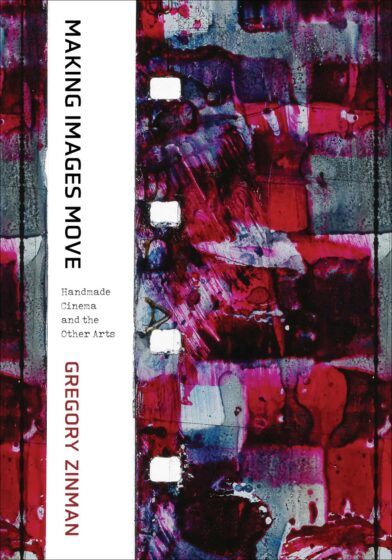Exploded View | For a Cameraless Cinema: Making Images Move: Handmade Cinema and the Other Arts

By Chuck Stephens
“That photography is not a prerequisite for handmade cinema’s production means that we can more easily come to view how artists used a variety of materials—not only paint, but also rain, oil, or electricity—as well as other media, technologies, and practices where cameras might be avoided, in order to pursue the goal of constructing time-based abstract compositions.”
Gregory Zinman’s excellent new book on movies made (or remade) through the direct, often tactile engagement of artists and their filmstrips, video-feedback loops, and myriad other animated oozes and vibrant viscosities, Making Images Move: Handmade Cinema and the Other Arts is everything one wants in this age of over-scribbling at the margins of cinema. Lucid, smart, but entirely readable, and compellingly illuminated with colour illustrations of the wonders it describes, Making Images Move is formidable historiography: it’s a volume you’ll want to display proudly on your shelf, somewhere between Gene Youngblood’s Expanded Cinema and Amos Vogel’s Film as a Subversive Art. High praise indeed, but Zinman easily earns it. Ten minutes after picking up the book I was noting the names of artists and filmmakers whose work I’d yet to explore, setting the book briefly aside to search for titles on Vimeo and discovering, for example, the “handmade Rorschach test” abstractions of Josh Lewis’ Doubt films (www.joshlewisfilm.com/Doubt), and feeling cinema expand once again, page by fascinating page.
As much a work of art history as film and media studies, Zinman’s book moves deftly between disciplines, always aware of the critical discourse already in play. A discussion of the interconnectedness of Stan Brakhage’s films with abstract expressionist painting, for example, is as attuned to J. Hoberman’s thoughts on the matter as it is careful to further delineate the specific confluences between the filmmaker and his canvas-based compatriots: “The attachments between closed-eye vision and the compositional style of Pollack or de Kooning or Joan Mitchell are replaced by an exploration of the tension between language and abstraction—one that is also evident in the gestural works of Franz Klein, Cy Twombly, and Yves Klein. As with those painters’ assertive mark making, Brakhage’s brush marks at times resemble calligraphy without resolving into easily readable signs, producing instead striking curves and angles that allow them to be identified as images that double as authorial signatures.” Of course, Brakhage is the name one reflexively expects to find elucidated in such a volume, and Zinman’s analysis of the varieties and meanings of that filmmaker’s various and variously crafted handmade films doesn’t disappoint, but the discussion of that titan’s contributions to the continuum the author intends to survey occupies only a dozen pages in a volume of some 300. (That’s not even a Brakhage still on the book’s cover, by the way: it’s Luther Price’s Inkblot #3.) Making Images Move is a song of everything, and the lattice of names, gizmos, artifacts, cultural moments, and political manifestos written in light that Zinman has interwoven throughout is exhilarating.
Zinman locates the progenitors of modern cameraless moviemakers in (among others) the “cameraless photography” of Man Ray and Laszlo Moholy-Nagy, and in “piecemeal transcendentalist” Thomas Wilfred’s lumia (projected plays of light involving “reflective mirrors, hand-painted glass discs, and bent pieces of metal,” which the author surprisingly doesn’t connect with Ken Jacobs’ materially similar Nervous Magic Lantern). He prefaces his passages on Brakhage not only with Len Lye and Harry Smith; the aggro and annihilationist aesthetics of the Lettrists are pertinently positioned as well. The historical energies, in situ unrepeatability, and contemporary re-emergence of psychedelic light shows produced by Silver Wing Turquoise Bird and Joshua Light Show are given a chapter of their own, but the pages on Tony Conrad’s recipes for a “cooked cinema”—a can of deep-fried EK 7302 16mm, some poisonous “Roast Kalvar”—should alone be enough to impress both the hip and the jaded. There’s much more to discover, but I’ll stop before this turns into a list (fuck lists), because Zinman’s book is much more than that. It’s a major work. A manuscript for the most discerning libraries. Pricey, but worth it. Oh, what the hell, boomer: go ahead and call it a tome.
Chuck Stephens- « Previous
- 1
- 2


